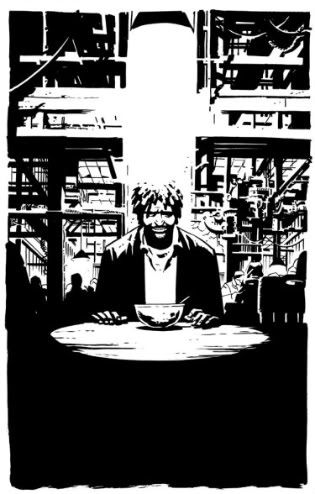My co-blogger, friend and all around good guy, Jon Gorga, made Quotes on Comics!
 Isn't that a sweet way to start a new year?
Isn't that a sweet way to start a new year?
 Isn't that a sweet way to start a new year?
Isn't that a sweet way to start a new year?
 All that said, Zachary Kanin's short and jocular adaptation of the story of Noah and the flood is far from bad. It's light and fun material and any fan of either Bill Cosby's or Eddie Izzard's hilarious stand-up bits recounting the story of Noah will find much to enjoy here. Kanin packs a lot of great stuff into four pages. Stuff like the two panels in which Noah is revealed to be a nose picker and the narrator declares "Well, not totally righteous" followed immediately by a panel where God says: "But good enough!" The effect is a bit of humanizing while poking fun at a Biblical figure.
All that said, Zachary Kanin's short and jocular adaptation of the story of Noah and the flood is far from bad. It's light and fun material and any fan of either Bill Cosby's or Eddie Izzard's hilarious stand-up bits recounting the story of Noah will find much to enjoy here. Kanin packs a lot of great stuff into four pages. Stuff like the two panels in which Noah is revealed to be a nose picker and the narrator declares "Well, not totally righteous" followed immediately by a panel where God says: "But good enough!" The effect is a bit of humanizing while poking fun at a Biblical figure.
 I don't like winter break very much. It's not that I don't like the time off (I do), and it's not like I don't like my family (I love them, that's why I come home), there just isn't very much to do in Chicago's north suburbs in late December and early January. Rather than find things to occupy me, then, I have often to make them.
I don't like winter break very much. It's not that I don't like the time off (I do), and it's not like I don't like my family (I love them, that's why I come home), there just isn't very much to do in Chicago's north suburbs in late December and early January. Rather than find things to occupy me, then, I have often to make them. If you are at all a fan of Joss Whedon's ongoing sci-fi story: TV's "Firefly" and its feature film sequel "Serenity", you have been waiting for this comic even if you didn't know it, because you've been waiting for this story for a long time. And it does not disappoint. If you're not familiar with Joss Whedon's 'verse this may very well be the place to start.
If you are at all a fan of Joss Whedon's ongoing sci-fi story: TV's "Firefly" and its feature film sequel "Serenity", you have been waiting for this comic even if you didn't know it, because you've been waiting for this story for a long time. And it does not disappoint. If you're not familiar with Joss Whedon's 'verse this may very well be the place to start.
 Now that I sufficiently sound like I'm obsessed with Chris Samnee and you think he's paying The Long and the Shortbox Of It money for these positive reviews both Josh and I have given him now... let's move on to the story.
Now that I sufficiently sound like I'm obsessed with Chris Samnee and you think he's paying The Long and the Shortbox Of It money for these positive reviews both Josh and I have given him now... let's move on to the story.